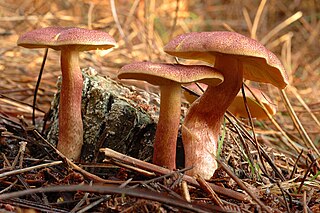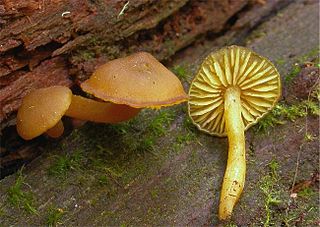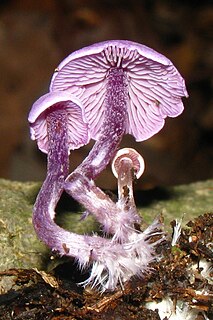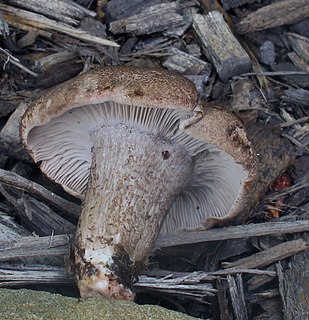
Tricholomopsis is a genus of fungi closely related to the large genus Tricholoma. Its best known member and type species is Tricholomopsis rutilans. The name means appearing like Tricholoma. The genus has a widespread distribution, and contains about 30 species. Tricholomopsis was described in 1939 by American mycologist Rolf Singer.

Pseudohiatula is a genus of fungi in the family Physalacriaceae. It was originally described as a subgenus of Mycena by the mycologist Rolf Singer before he moved to its own genus two years later. It was formerly thought to belong in the family Tricholomataceae, but a molecular phylogenetics study found it to be more closely The genus Cyptotrama in the Physalacriaceae. Rolf Singer had previously hypothesized these two genera to be closely related based on morpological features in 1986. It contains five species that are widely distributed in tropical areas.
Callistodermatium is a fungal genus in the family Tricholomataceae. It is a monotypic genus, and contains the single species Callistodermatium violascens. The holotype was found in Brazil, and described by mycologist Rolf Singer in 1981.
Mycoalvimia is a genus of fungus in the Tricholomataceae family. It is a monotypic genus, and contains the single species Mycoalvimia theobromicola, found in Brazil.
Pegleromyces is a genus of fungi in the Tricholomataceae family. It is a monotypic genus, containing the single species Pegleromyces collybioides, found in Brazil and described as new to science by mycologist Rolf Singer in 1981.

Callistosporium is a genus of fungi in the family Tricholomataceae. The genus is widespread, and contains 13 species.
Dennisiomyces is a genus of fungi in the family Tricholomataceae. Described by mycologist Rolf Singer in 1955, the genus contains five species found in South America.

Fayodia is a genus of fungi in the Tricholomataceae family. It was first described by Robert Kühner in 1930, and the specific epithet honors the Swiss mycologist Victor Fayod. The widespread genus contains 10 species, mostly in the northern temperate regions.

Leucoinocybe is a fungal genus in the family Tricholomataceae. This is a monotypic genus, containing the single species Leucoinocybe lenta, found in Europe.

Mycenella is a genus of fungi in the Tricholomataceae family. The widespread genus contains 10 species, found mostly in temperate regions. Mycologist Rolf Singer circumscribed the genus in 1938.

Phyllotopsis is a genus of fungi in the Tricholomataceae family. The widespread genus contain five species that are predominantly in temperate regions.
Physocystidium is a genus of fungi in the Tricholomataceae family. This is a monotypic genus, containing the single species Physocystidium cinnamomeum. This species is found in Trinidad, and was originally described as new to science in 1951 as Collybia cinnamomea by mycologist R.W.G. Dennis; Rolf Singer transferred it to the then newly created genus Physocystidium in 1962.

Pseudobaeospora is a genus of fungi in the family Tricholomataceae. A 2008 estimate placed about 20 species in the widespread genus.

Rimbachia is a genus of fungi in the Tricholomataceae family. The genus contains about ten species with a widespread distribution in tropical regions.

Nothoclavulina is a genus of fungus in the Tricholomataceae family. The genus is monotypic, containing the single species Nothoclavulina ditopa, described by American mycologist Rolf Singer in 1970. The species, found in Argentina, is an anamorphic version of the genus Arthrosporella. The generic name Nothoclavulina is Latin for "false Clavulina".
Pogonoloma is a mushroom genus in the family Tricholomataceae in a broad sense. The genus contains two species known from Europe. Pogonoloma was described first as a subgenus of the genus Porpoloma but recent molecular evidence separates the two by several other genera, with Porpoloma remaining within a smaller family Tricholomataceae.












